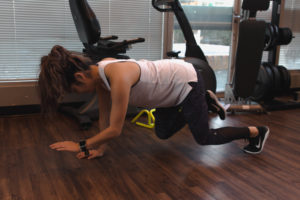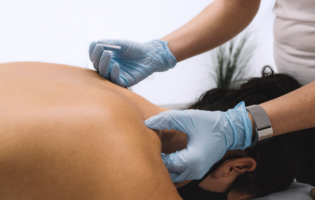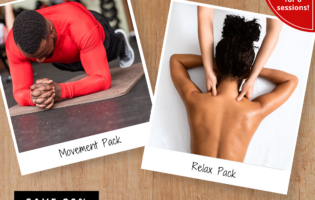Total Therapy Blog

Physical Literacy Part 2: Bear Walks
Bear Walks, from the physical literacy point-of-view
(If you’d like a recap on what physical literacy is, check out this post here.)
 When I worked with a much younger crew– I’m talking starting at 6 months– it was incredibly cool and a huge privilege to get to see these little humans learning to move their little bodies for the first time ever. In between just hanging out in tummy time and crawling, babies learn to lift their head and chest up. This is a pretty big deal: finally some stability to those floppy necks! Tummy time is the first chance for babies to strengthen the neck and mid-back, which might sound familiar as Very Important Muscles™ if you’ve gone through any postural retraining.
When I worked with a much younger crew– I’m talking starting at 6 months– it was incredibly cool and a huge privilege to get to see these little humans learning to move their little bodies for the first time ever. In between just hanging out in tummy time and crawling, babies learn to lift their head and chest up. This is a pretty big deal: finally some stability to those floppy necks! Tummy time is the first chance for babies to strengthen the neck and mid-back, which might sound familiar as Very Important Muscles™ if you’ve gone through any postural retraining.
 After this milestone, in my experience of watching and encouraging, every other physical stage is a toss-up. Some kids start to immediately walk, others master crawling to its maximum speed; there are half-and-halfers and then some are sprinting like walking’s an optional stage and they just aren’t about it. Wherever they were at, we coaches encouraged the bear walk skill; not just because it was fun (“RAWR!”) but also because it strengthens everything, for everyone, to even out every physical playing field. The immediate walkers get another chance to strengthen their upper body and neck. Speed demons can strengthen their legs and feet for the next stage: walking. Half-and-halfers get another skill to half-and-half so they can third-a-third-a-third, which is awesome because they’re all beneficial. And sprinters– well, maybe this will slow them down for once so they can finally be caught?
After this milestone, in my experience of watching and encouraging, every other physical stage is a toss-up. Some kids start to immediately walk, others master crawling to its maximum speed; there are half-and-halfers and then some are sprinting like walking’s an optional stage and they just aren’t about it. Wherever they were at, we coaches encouraged the bear walk skill; not just because it was fun (“RAWR!”) but also because it strengthens everything, for everyone, to even out every physical playing field. The immediate walkers get another chance to strengthen their upper body and neck. Speed demons can strengthen their legs and feet for the next stage: walking. Half-and-halfers get another skill to half-and-half so they can third-a-third-a-third, which is awesome because they’re all beneficial. And sprinters– well, maybe this will slow them down for once so they can finally be caught?
Do you remember bear walks from organized sports? It was a classic form of torture conditioning, alongside the dreaded lines and burpees. But here’s why our coaches justified this bear walk (torture method) drill:
- It strengthens the neuromuscular coordination between opposite arm and opposite leg (just like walking or running);
- Strengthens core (abs, six-pack, washboard, one of Zac Efron’s many money makers, etc.);
- Strengthens back muscles, best showcasing the latissimus dorsi (‘lats’);
- Strengthens the glutes, medius and maximus (and minimus but let’s not bother with that right now);
- Okay cut to the chase: it strengthens everything! This is especially great for kids, who are supple and mobile and need to build some stability.
- Learning to stabilize using core, shoulder, and hip stability; and not giving into fatigue. For athletes, this keeps them strong in their sport. For adults, fatigue could be working a physical job for 8 hours a day.
- Not only stability but mobility is challenged as well. The shoulders and hips move in a range of motion without giving into your body weight– now that’s dramatic. Depending on your goals, you could use this exercise for either! In children, it promotes both.

All 7 of these are important components of a physically fit body that is injury-free and able: we’re able to hold good posture with minimal fatigue; move around and do what we want to do (or have to do *ahem* I’m looking at you, pile of dishes); and have enough energy in the reserves for anything out of the ordinary (like sprinting for an early bus or going for a long hike).
Bear walks were an enthusiastically celebrated milestone in my Coach Mae days, and the physical literacy lessons they taught me are still valuable now. The stuff they provide kids with is important for adults too; but it takes a lot to perform bear walk correctly, and not everyone is able to do them. You might have to take the movements apart and work on bits and pieces on their own, rather than doing the full bear walk exercise. If you have any doubt, you can always chat with a friendly professional for advice!
If you’re wondering about physical literacy for your little one, hop over to my friends over at Jump Gymnastics! Jump is for kids ages 6 months to 8 years, but this quick 2-minute video by the amazing Jen is chock-full of information that anyone can learn from.








Follow Us!
& Stay Up To Date
BLOG